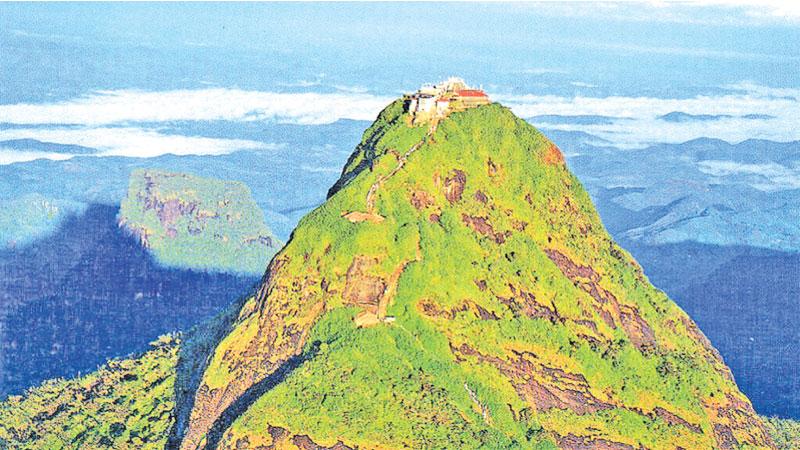
Sri Pada (Adam’s Peak} is a sacred mountain that members of four major religions worship.
This conical shapedmountain is in the district of Ratnapura, in the Sabaragamuwa Province. It towers at a height of 2243 metres (7360 feet).
The Mahawamsa states that the Buddha visited Sri Lanka thrice.
During the third visit he travelled from Kelaniya to Sri Pada, and then to Digavaphi. It is said that the Buddha left his footprint on a rock at the top of the mountain at the invitation of God Saman.
It is recorded that God Saman met the Buddha on his first visit to the island when he visited Mahiyangana.
God Saman is the guardian deity of Sri Lanka.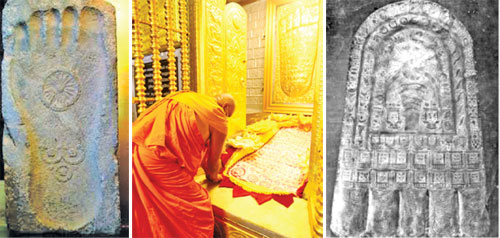
Landmark
It is said that Sri Pada, the Holy Mountain was the landmark of sea-faring Arabs,who came to Sri Lanka,to trade gem, ivory, spices and herbs.
According to the Englishman John Davy, who visted the summit in 1817, “It is a superficial hollow, five feet three inches and three-quarters long, and between two’ feet seven inches and two feet five inches wide.
It is ornamented with a margin of brass, studded with a few gems, of little value: it is covered with a roof, which is fastened to the rock by four iron chains, and supported by four pillars; and it is surrounded by a low wall.
The roof was lined with coloured cloths, and its margin being decked with flowers, and streamers, it made a very gay appearance. The cavity certainly bears a coarse resemblance to the figure of the human foot.”
A similar print in Thailand is believed to have the imprint of the Buddha’s right foot. It is about five feet long and two feet broad.
The sacred footprint
The authentic footprint on Adam’s Peak is believed to be set in jewels beneath the visible rock.
The soles of the Buddha’s feet are said to be flat with all the toes of equal length. On each sole there are one hundred and eight auspicious marks , with the wheel (chakra) the principal mark at the centre while around it are grouped figures of animals, inhabitants of various worlds and other types of symbols.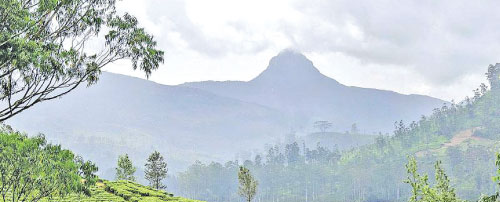
Buddhists knew that this holy footprint had been made by the Buddha long before (as far as the 1st century BC) any other religion was introduced to the country.
But in the succeeding centuries other faiths such as Islam, Hinduism and Christianity laid claim to it. Muslims believe the footprint to be that of Adam (hence the name Adam’s Peak).Christians believe it to be that of St. Thomas, the disciple of Jesus and Hindus believe it to be that of God Siva.
The Tamil name of the mountain is Civan-oli-pata (the mountain path of Siva’s light) or Svargarohanam (ascent to heaven).
First historical mention
The first historical mention about Sri Pada comes during the reign of Vijayabahu (1055-1110). Earliest historical evidence in chronicles and inscriptions record that the king having seen the difficulties undergone by the pilgrims on their way to worship the Sri Pathula (Buddha’s Foot Print) on Samanthakuta dedicated the village named Gilimale to provide for their needs. Stone inscriptions of Vijayabahu have been found at Gilimale and Ambagamuwa confirming the record of the chronicle.
It was King Nissanka Malla ( 1187-1196) who reigned from Polonnaruwa who started the pilgrimage after he ascended the mountain with his four fold army with great faith and devotion.
The Sri Pada Season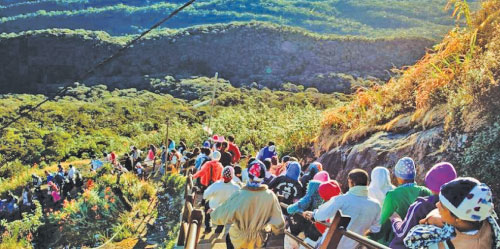
The Sri Pada Season starts from the Unduvap full moon poya day in December and ends in May on Vesak Poya day.
Generally, it take 5-6 hours to reach the top of the mountain.
When the season starts many shops pop up on the way to the summit of the mountain offering a variety of food and drink .
The top of the mountain is windy and chilly.
The route
There are two approaches to the summit of Sri Pada.
The oldest is the Ratnapura path (climb starts from Erathna), popularly known as the ‘difficult path’.
This is a beatentrack infested with leeches and very few use this path.
The Seetagangula (the icy water river) which is the parent of Kalu ganga is found halfway upon the climb.
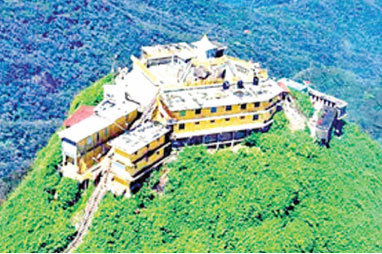 This route is definitely the path to take for an experienced trekker who wants to avoid crowds.
This route is definitely the path to take for an experienced trekker who wants to avoid crowds.
The other path is the Hatton path (climb start from Nallatanniya) called the Raja Mawatha in ancient times because many kings have used this path to reach the mountain top.
This is the most common path used by the pilgrims. There are resting places with small boutiques every few hundred steps during the season.
There are several ways to get to Hatton.
You can take a bus or the train from the Colombo. Once at Hatton take one of the numerous private buses to the foot of the mountain, of about 33 kilometres.
Ira Sevaya
The Ira Sevaya is the most spectacular sight seen by by pilgrims who climb to Sri Pada’s summit
This miraculous sight eastern sky is seen in the early moning.
These variations of the sun’s image is really is t a most beautiful and colourful sight.
Some believe that the Sun moves up and down to worship the footprint of the Buddha.
Most people start climbing at night to get to the summit of Adam’s Peak before dawn to see the Ira Sevaya.
Udamaluva
After climbing a long distance people reach the Udamaluva, the summit of the mountain to worship the Buddha’s footprint.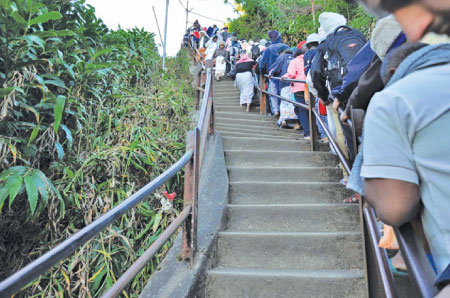
A beautiful view can be seen from the Udamaluwa.
Everyone wants to go to Sri Pada and get blessings at least once in their life time Even during this pandemic some people visit this amazing mountain!
H.G. Sasmi Sithumsa
Grade 6
Lyceum International School
Ratnapura
